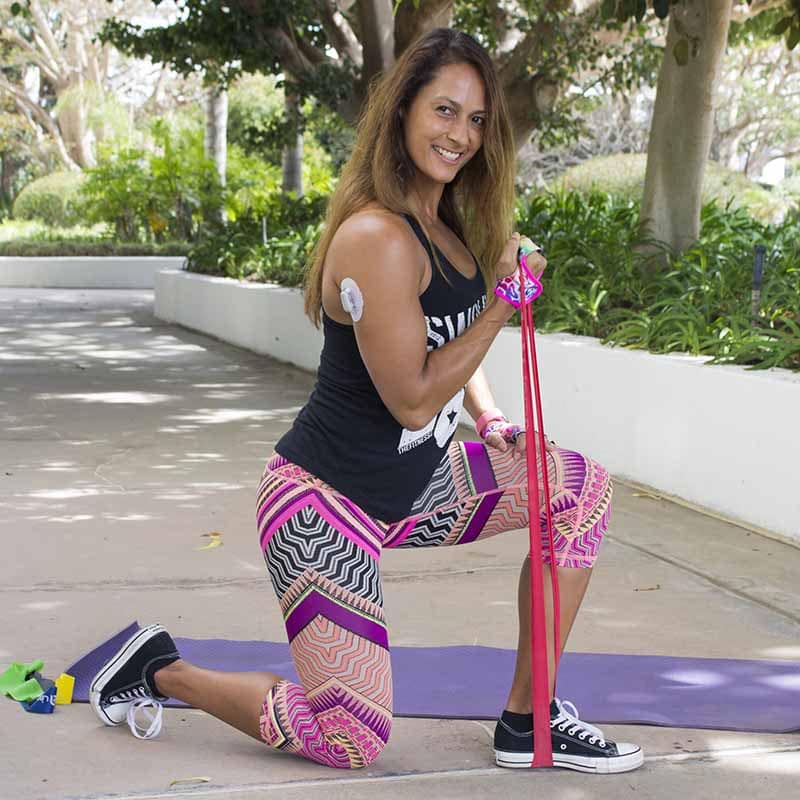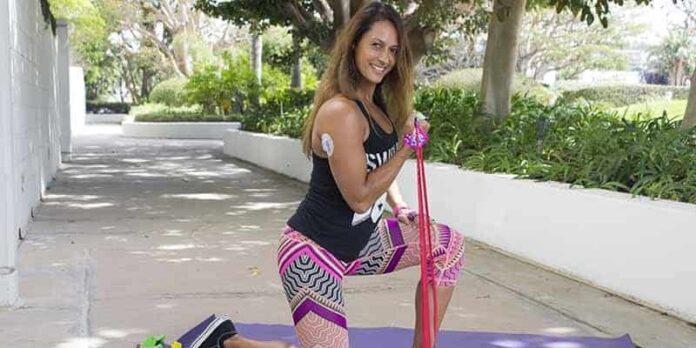You may have seen me sporting my Dexcom CGM in some of my workout videos. I love my Dexcom, but it has taken me a while to learn how to wear it all the time without irritation or itching, and without the adhesive tape falling off after a few days.
These CGM tips and tricks are based on my experience with the Dexcom CGM but they should work for most other CGM brands as well.
Because I am very active (and live in sunny California), a typical day for me includes getting sweaty, showering, getting sweaty again, etc. I love it, but it makes having a CGM glued to my body a little challenging sometimes. That’s why I want to share my 5 favorite CGM tips with you – so you can enjoy a more comfortable CGM too!
CGM tip 1 – Use Skin-Tac™ Adhesive Wipes to add extra adhesive to the sensor
If you find that your CGM falls off very quickly, Skin-Tac could be the solution for you. It’s basically body glue that you apply to your skin and allow to dry before attaching the sensor. It makes the skin super sticky, so it acts as an extra adhesive. I’ve never liked it too much since I’d get glue all over the place, but I know plenty from the diabetes community who love it.
Some also add Skin-Tac if the sensor starts coming off after a few days. Just add a little adhesive under the edge and reattach it that way. Again, this method doesn’t work super well for me, maybe because it’s pretty hard to clean the area where the sensor has come loose.
It’s somewhat challenging to get off (from the area where you applied it as well as your hands), so I do recommend using the adhesive remover wipes to get the adhesive off.
CGM tip 2 – Use GrifGrips instead of overlay tape to reduce itching in warm weather
Regular overlay tape (see trick #3) can make my skin irritated when the weather is really warm or I’m doing a lot of cardio, so I’ve found fabric patches like GrifGrips much more usable (see my CGM patch review for more info). They were originally designed with an active lifestyle in mind, and they really do the job! This is one of my top CGM tips for summer
They keep the sensor in place without irritating my skin at all. Since the texture of the patch is more like a big bandage than plastic, it doesn’t feel like I’m wearing a patch and I forget about it pretty quickly.
For me, the downside is that the patch looks like a giant bandage and isn’t see-through like the tape is. You can get a lot of different colored GrifGrips, but they are all very visible. I don’t mind showing my CGM, but the in-your-face color choices are just a little too much for me sometimes. But if you are into colorful patches, their products are for you.


CGM tip 3 – Use overlay tape to secure the sensor
One thing to like about the overlay tape is that it’s completely see-through, so unless you are all up and close, you don’t notice that there’s an extra tape over the sensor. There’s nothing fancy about this tape, except for the grid that’s printed on the paper side, which makes it easier to measure out and cut straight. Other brands will most likely do the jobs just as well, so don’t worry if you can’t get this one.
The one big downside I’ve found to the overlay tape is that when I do a lot of cardio, or the weather is warm enough that I sweat a lot, the tape really irritates my skin. After a few days, my skin gets red and itchy, which is far from optimal. So for me, it’s more of a fall/winter solution. In the summer, I use GrifGrips instead (see trick #2)”
CGM tip 4 – Use a tag cutter to cut your overlay tape
Of all my CGM tips, this is probably my favorite – this trick is brilliant! This little device will punch a perfect Dexcom-sized hole in the overlay tape. If you’ve ever tried to cut a hole in overlay tape, you know that it’s a pain, and pretty much impossible to do without it looking like it was cut by a four-year-old with dull scissors.
Of course, you might be more gifted than I am at cutting holes, and having the grid printed on the tape should make it easier, BUT…
A diabuddy recommended this tool to me, and it’s amazing. It’s not at all designed for cutting perfectly Dexcom-sized holes in tape – it’s actually meant to be a tag-punching device (you know for birthday gifts and such). But if you follow the link to Amazon and have a look at what other products people buy along with this, it’s all diabetes-related stuff. Even the reviews are all diabetes-related.
CGM tip 5 – Find the right CGM placement for you
I’ve found that where I place the sensor has the largest impact on my overall comfort level, so it’s one of my most important CGM tips. I prefer to place it on my lower back or the back of my upper arms (the triceps). This is where there is the least chance of me bumping into something and tearing it off.
It can be a little tricky to insert the CGM on the upper arm without help, so I made this short video to show how I do it.
On my lower back, I’ve found that I need to place it just above my belt/pants. If I place it below my belt, there’s a larger chance of me pulling it off whenever I wear jeans (yes, I wear very tight jeans), and I find it uncomfortable to have my pants pushing on the sensor. I also want to keep the sensor away from places where I bend. Optimally, I’ll attach it horizontally to minimize the chance of it getting in the way when I move around. Imagine doing a side crunch while trying to avoid being prodded by the sensor every time.
Placing the sensor optimally can be challenging and some sites I just can’t do on my own, so Tobias will sometimes lend a helping hand. And then there are some sites that just scare me, so I haven’t built up the nerve to try them yet (I’ve seen folks wear them on their calves!!).
I hope you found some of my CGM tips useful, and I would love to hear yours! What’s your best CGM tip?
Suggested next post: The Ultimate Diabetic Gift Guide

